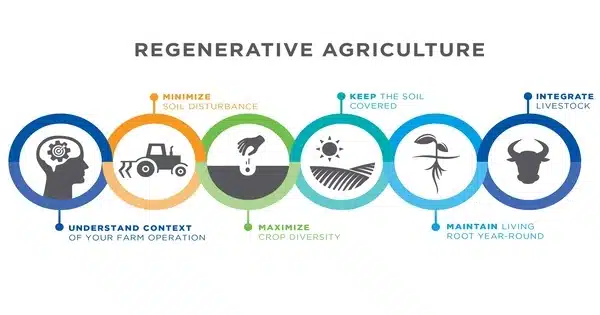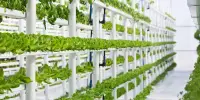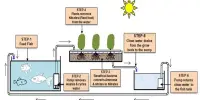Regenerative agriculture focuses on restoring soil health that has been harmed by the use of heavy machinery, fertilizers, and pesticides in intensive farming. It is a comprehensive strategy to farming and land management that focuses on improving and restoring ecosystem, soil, and environmental health while providing food and other agricultural goods. Within the next 50 years, there may not be enough soil to grow enough food to feed the globe. Regenerative agriculture’s main ideas strive to operate in harmony with nature, increase biodiversity, and develop sustainable, resilient farming systems.
Regenerative agriculture and other climate-friendly farming approaches can raise farmer revenue while also lowering emissions and improving soil health. It is not a distinct discipline in and of itself. Instead, proponents of regenerative agriculture combine a number of sustainable agriculture practices. Practices include recycling as much farm waste as possible and using composted material from outside sources.
Some key aspects of regenerative agriculture include:
- Soil Health: It emphasizes the importance of creating and maintaining healthy soils. Soils that are healthy are rich in organic matter, teeming with helpful microbes, and have a nice structure. To increase soil health, techniques like as limited tillage, cover cropping, crop rotation, and the use of organic matter (such as compost) are often used.
- Biodiversity: The promotion of biodiversity is a key component of regenerative agriculture. Diverse ecosystems are stronger and can endure pests, illnesses, and harsh weather occurrences. Farmers can incorporate strategies such as planting hedgerows, establishing pollinator habitats, and protecting natural areas into their farms.
- Crop Rotation and Diversity: Instead of monoculture farming, where a single crop is grown continuously, regenerative agriculture promotes crop rotation and the cultivation of a variety of crops. This helps break pest and disease cycles and enhances soil fertility.
- Cover Cropping: Planting cover crops, such as legumes and grasses, during fallow periods or between main crops helps prevent soil erosion, adds organic matter to the soil, and improves nutrient cycling.
- Reduced Chemical Inputs: Regenerative farming seeks to minimize the use of synthetic chemicals like pesticides and fertilizers. Instead, it often relies on organic or natural alternatives, biological pest control, and nutrient management through soil health practices.
- Livestock Integration: Integrating livestock, such as cattle, sheep, or chickens, into agricultural systems can contribute to soil health through techniques like rotational grazing. Livestock can also help recycle nutrients and improve nutrient cycling.
- Water Management: Water management practices such as conservation tillage and the construction of swales and berms can assist in conserving moisture in the soil, limit water flow, and alleviate erosion.
Regenerative agriculture is a departure from standard industrial agricultural practices, which frequently degrade soil, destroy ecosystems, and contribute to environmental challenges. It attempts to establish farming systems that are not only productive but also environmentally and socially responsible. This strategy has grown in favor as worries about sustainability, food security, and climate change have grown.
















